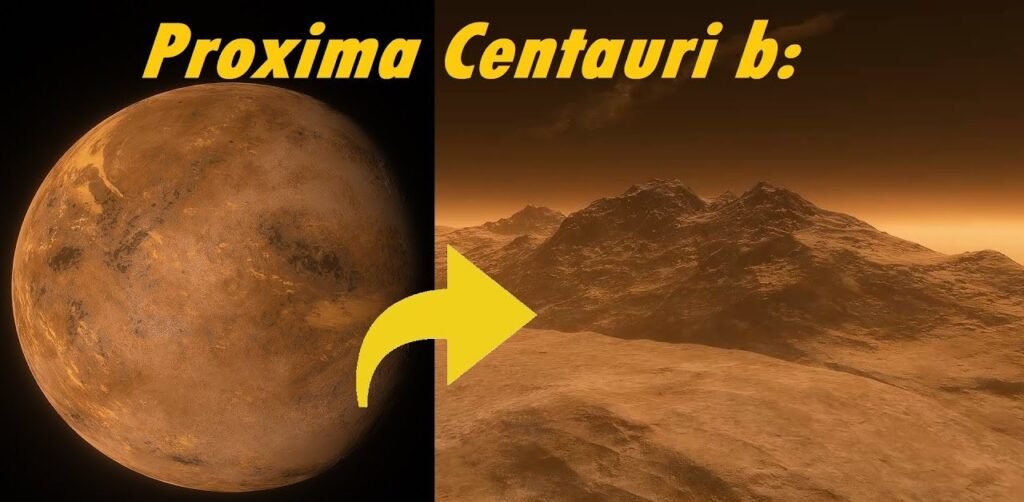What is the closest habitable planet to Earth? The closest extrasolar planets overall to Earth are Proxima Centauri b, c, and d, each located 4.22 light years away from Earth. Proxima b is the closest potentially habitable planet to Earth. Proxima Centauri b is located within the classical habitable zone of its star and receives about 65% of Earth’s irradiation. Its equilibrium temperature is estimated to be about 234 K (−39 °C; −38 °F). Here’s a detailed look at what makes Proxima Centauri b an exciting candidate for habitability:
Proxima Centauri b

- Location: Proxima Centauri b orbits Proxima Centauri, which is the closest known star to the Sun. Proxima Centauri is part of the Alpha Centauri star system, located approximately 4.24 light-years away from Earth in the constellation Centaurus.
- Discovery: Proxima Centauri b was discovered in 2016 by astronomers using the radial velocity method, which detects wobbles in a star’s motion caused by the gravitational pull of orbiting planets.
- Characteristics:
- Mass: Proxima Centauri b has a minimum mass of about 1.17 times that of Earth. This suggests that it could be a rocky planet like Earth.
- Orbit: It orbits its star at a distance of approximately 0.05 astronomical units (AU), which is much closer than the Earth-Sun distance of 1 AU. However, since Proxima Centauri is a red dwarf star, it emits less light and heat, placing Proxima b within the star’s habitable zone.
- Orbital Period: The planet completes an orbit around Proxima Centauri roughly every 11.2 days.
- Habitable Zone: Proxima Centauri b is situated within the habitable zone of its star. The habitable zone is the region around a star where conditions might be right for liquid water to exist on a planet’s surface, a key factor for potential habitability.
- Potential for Life:
- Surface Temperature: If Proxima Centauri b has an atmosphere capable of trapping heat (like Earth’s greenhouse gases), the planet might support liquid water. Without an atmosphere, it could be too cold or too hot for life as we know it.
- Atmosphere: The presence and composition of an atmosphere on Proxima Centauri b remain unknown. The planet is exposed to higher levels of stellar radiation due to its proximity to Proxima Centauri, which could strip away any atmosphere over time. However, if it has a magnetic field, it might protect an atmosphere, offering a more stable climate.
What is the closest habitable planet to Earth? Challenges for Habitability
- Stellar Activity:
- Proxima Centauri is known for being a highly active star, frequently emitting solar flares that can significantly increase the radiation reaching Proxima Centauri b. This stellar activity could pose challenges for the development or sustainability of life by stripping away any atmosphere or altering surface conditions.
- Tidally Locked:
- Proxima Centauri b is likely tidally locked, meaning one side of the planet constantly faces the star, while the other side remains in perpetual darkness. This could create extreme temperature differences between the day side and the night side, potentially making climate stabilization difficult.
- Atmospheric Conditions:
- The potential lack of a thick atmosphere could prevent Proxima Centauri b from maintaining stable temperatures or liquid water. Understanding whether the planet has an atmosphere is crucial for assessing its habitability.
Other Potentially Habitable Exoplanets
While Proxima Centauri b is the closest potentially habitable exoplanet, several other exoplanets have been identified as candidates for habitability. Here are a few notable ones:
1. Ross 128 b
- Location: Located about 11 light-years away in the constellation Virgo, orbiting the red dwarf Ross 128.
- Characteristics: Ross 128 b is similar in size to Earth and is located within its star’s habitable zone. The star is much less active than Proxima Centauri, reducing the likelihood of harmful radiation exposure.
2. LHS 1140 b
- Location: Located about 40 light-years away in the constellation Cetus.
- Characteristics: This super-Earth is significantly larger than Earth and orbits within the habitable zone of its host star, LHS 1140. It may have retained a substantial atmosphere, making it a candidate for habitability studies.
3. TRAPPIST-1 System
- Location: Approximately 39.5 light-years away in the constellation Aquarius.
- Characteristics: The TRAPPIST-1 system consists of seven Earth-sized planets, three of which are located within the star’s habitable zone (TRAPPIST-1e, TRAPPIST-1f, and TRAPPIST-1g). These planets are intriguing candidates due to their size and potential for liquid water.
Future Exploration and Research
- James Webb Space Telescope (JWST): Launched in 2021, the JWST is poised to significantly enhance our understanding of exoplanet atmospheres, including those of potentially habitable worlds like Proxima Centauri b. Its advanced instruments allow for detailed spectroscopy to analyze atmospheric compositions and search for bio-signatures.
- Ground-based Telescopes: Upcoming observatories like the Extremely Large Telescope (ELT) and Giant Magellan Telescope (GMT) will provide more detailed observations of exoplanets, allowing astronomers to refine estimates of habitability and study surface conditions.
- SETI and Breakthrough Listen: Initiatives like Breakthrough Listen are searching for signals from intelligent life around nearby stars, including Proxima Centauri. Although no signals have been detected so far, ongoing efforts continue to explore the possibility of extraterrestrial life.
Conclusion
While Proxima Centauri b remains the closest potentially habitable exoplanet, its actual habitability is still uncertain. The challenges posed by its proximity to an active red dwarf star and the unknown nature of its atmosphere present significant obstacles. However, advancements in observational technology and ongoing research may soon provide more definitive answers about Proxima Centauri b and other intriguing exoplanets in our cosmic neighborhood.

